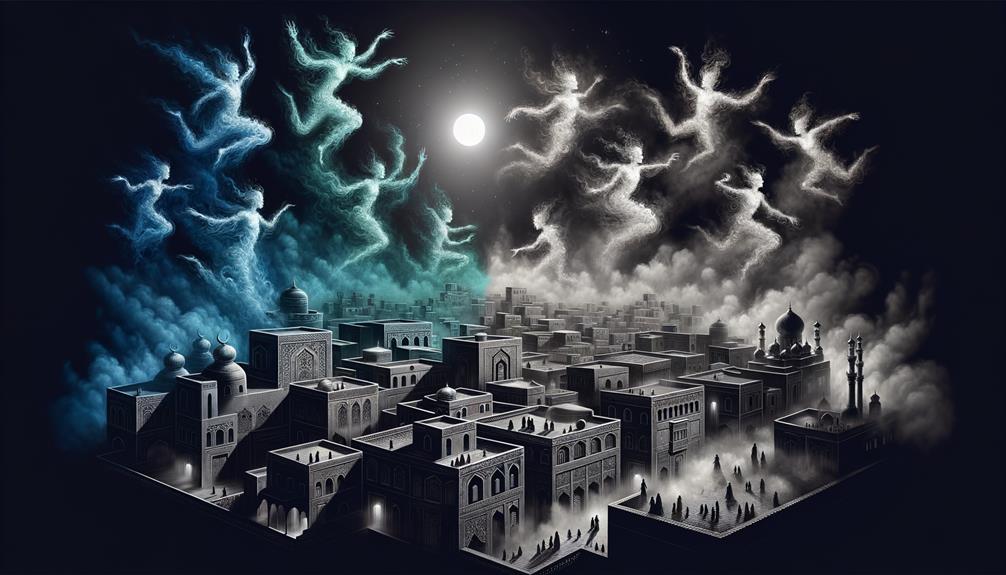Unveiling the Mystical Jinn of Arabian Mythology
Under the soft glow of my oil lamp, night after night, I've meticulously dissected the myths surrounding mystical entities across diverse cultures. However, the jinn of Arabian mythology never cease to captivate me. Born from smokeless fire, these unseen spirits transcend the stereotypical genies we know from Aladdin's tales. Their dual nature, neither entirely malevolent nor wholly benevolent, mirrors the characteristics of Celtic faeries or Persian djinn.
The Impact of Unseen Entities
These ethereal beings, despite their invisibility, make their presence felt in our physical world. They engage with humans, sometimes even inhabiting them, much like the spirits in ghost stories. As I map the journey of these multifaceted creatures across different cultural terrains, I ponder over how our understanding and portrayal of jinn have morphed over the centuries. Wouldn't it be fascinating to delve deeper into this topic?
Footprints of Jinn in Cultural Landscapes
The jinn's intriguing duality bears a striking likeness to other mythical creatures. For instance, the ambiguity of their nature is reminiscent of the Celtic faeries' capricious temperament. On one hand, they can be benevolent, much like the Seelie Court of Celtic folklore. On the other, they can exhibit malevolent traits akin to the Unseelie Court. Similarly, the Persian djinn, another variant of these spectral beings, conveys the same paradoxical nature.
Reflections of Our World Through Jinn
The evolution of the jinn's perception over time offers a mirror to our understanding of the world. It's a topic worth exploring, especially for those interested in mythology, folklore, or cultural studies. As we traverse through the rich tapestry of these mythical creatures' history, we begin to see our own world in a new light.
Dive Deeper into the World of Jinn
Ready to embark on this fascinating journey? Delve deeper into the world of jinn with books like "The Vengeful Djinn" by Rosemary Ellen Guiley or "The Jinn & Human Sickness" by Dr. Abu Ameenah Bilal Philips. Their insightful perspectives will guide you through the intricate maze of jinn mythology, enriching your understanding of these compelling entities.
Discover the Fascinating Jinn
Isn't it intriguing how unseen entities can influence our reality? Join me as we uncover the mysteries of the jinn, exploring their footprints across different cultures and times. Together, we can illuminate the dark corners of mythology and folklore, shedding light on how they reflect our understanding of the world.
Origins of Jinn Mythology

Unveiling the Origins of Jinn Mythology
The fascinating world of Jinn mythology has its roots firmly planted in the early religious customs of pre-Islic Arabia. This ancient legend evolved, finding a vital place within the Islamic culture, and its influence pervades the Quran and pre-Islamic literature. The term 'jinn' springs from a Semitic root, encapsulating their chameleon-like capacity to conceal or transform themselves, often morphing into human forms or other shapes to suit their whims.
The Jinn in Quranic Lore
The Quran, in its 72nd chapter, devotes considerable attention to these enigmatic beings, underlining their significance in Islamic mythology. The jinn, born from a smokeless flame, reflect a concept that was distinctly unique to the worldview of pre-Islamic Arabs. These beings aren't inherently good or evil, but rather, they encapsulate a range of moralities, mirroring the expansive human moral spectrum.
Jinn Stories: A Tapestry of Human Nature
The legendary 'Thousand and One Nights' resonates with tales of the jinn. Their vivid interactions with humans, their playful nature, and their potential for both kindness and maliciousness paint a striking portrait. The jinn, with their intricate duality, underscore the multifaceted and often paradoxical traits of humanity. Their mythology offers an intriguing window into the religious and cultural shifts from pre-Islamic to Islamic beliefs.
By delving deeper into the captivating lore of the jinn, one can gain a comprehensive understanding of these mystical beings and their significant role in shaping cultural narratives. Remember, exploring such myths not only engages the mind but also provides a broader perspective of the world's diverse cultures. Whether you're an avid reader, a history enthusiast, or a mythology buff, the intriguing tales of the jinn will undoubtedly captivate your imagination.
Unlock the Mysteries of Jinn Mythology
Jinn in Islamic Texts
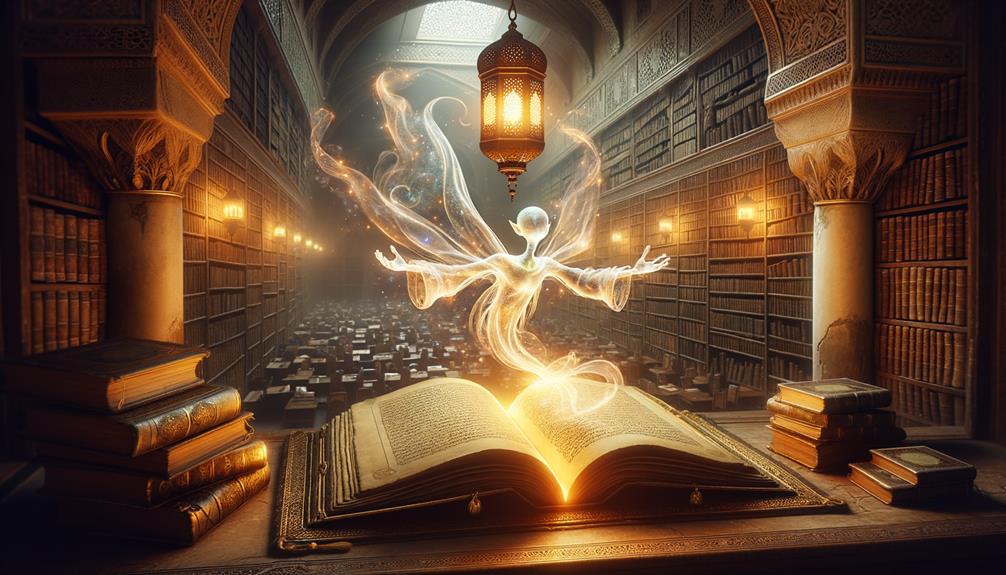
Discover the Mystical World of Jinn in Islamic Texts
Unravel the captivating narrative of jinn, woven into the intricate Islamic texts. These fascinating beings, born from smokeless fire, possess a unique duality as they oscillate between belief and disbelief in God's guidance. Their extraordinary abilities to morph forms and transcend the physical world catapult them into a realm beyond human comprehension – the mystical 'World of the Jinn'. The Islamic tradition is a treasure trove of tales about jinn, beings believed to have graced existence prior to humans.
Jinn in Saudi Arabian Scholarship
The rich tapestry of Islamic texts from Saudi Arabia, a region where belief in jinn is widespread, brims with insightful studies on these enigmatic beings. One notable contribution is the book 'Al-Jinn', which delves into the intricate nature of jinn.
- The Benevolent Jinn: The book introduces the concept of 'good jinn', those who choose to embrace God's guidance.
- Inside the Jinn Hierarchy: It further dissects the hierarchy within the jinn world, culminating with the 'King of the Jinn'.
- The Human-Jinn Interface: Lastly, it scrutinizes the interactions between humans and jinn, including the intriguing belief in jinn possession.
Uncovering the Arabian Mythical Spirits
These insights offer a mesmerizing exploration into the role of jinn – the mythical spirits of Arabia – in the Islamic texts and beliefs. We invite you to delve into this captivating subject, a cornerstone of Islamic culture, and unravel the mysteries surrounding these enigmatic beings.
Cultural Representation of Jinn
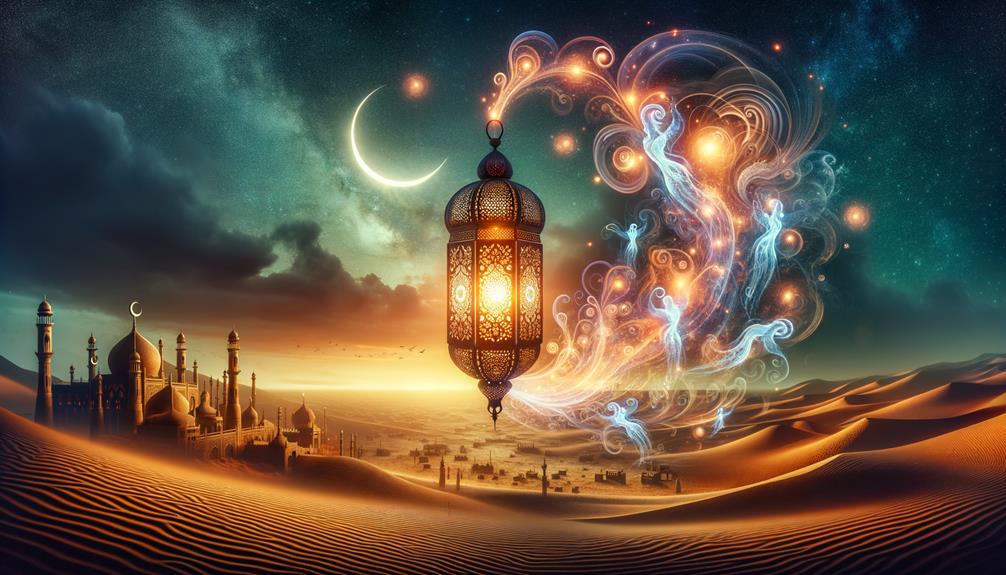
Understanding the Cultural Significance of Jinn
Let's dive into the captivating world of jinn – shape-shifting spirits that have found a home in countless cultural narratives. They're not just creatures of Islamic theology, but characters etched into the vibrant fabric of folklore and popular culture. They don't lean inherently towards good or evil; rather, their portrayal changes from story to story, keeping us on our toes.
Jinn in the Middle East: Powerful yet Manageable
One of the most compelling regions where jinn stories are deeply rooted is the Middle East. Here, jinn are painted as mighty beings with a knack for influencing human actions. An intriguing example of this is the tale of King Solomon, who supposedly used the power of jinn to construct his splendid temple. This story solidifies the image of jinn as formidable, yet controllable spirits, shaping the public's perception and understanding of these entities.
Jinn in Modern Pop Culture: A Spectrum of Characters
Turning to the realm of contemporary pop culture, jinn have made quite a mark. From the friendly "genie in the lamp" in Aladdin to the sinister spirits in the latest horror movies, jinn take on a myriad of roles. Each representation unveils a new side of their multifaceted character. They can be protectors, tricksters, or malevolent forces – each interpretation giving us fresh insight into these enchanting mythical beings.
The Ever-evolving Representation of Jinn
The cultural representation of jinn is far from static. It continues to evolve, offering us an enriched understanding of these intriguing spirits. Through various forms and narratives, jinn maintain their allure, proving to be a source of boundless fascination and exploration.
Jinn in Magical Practices
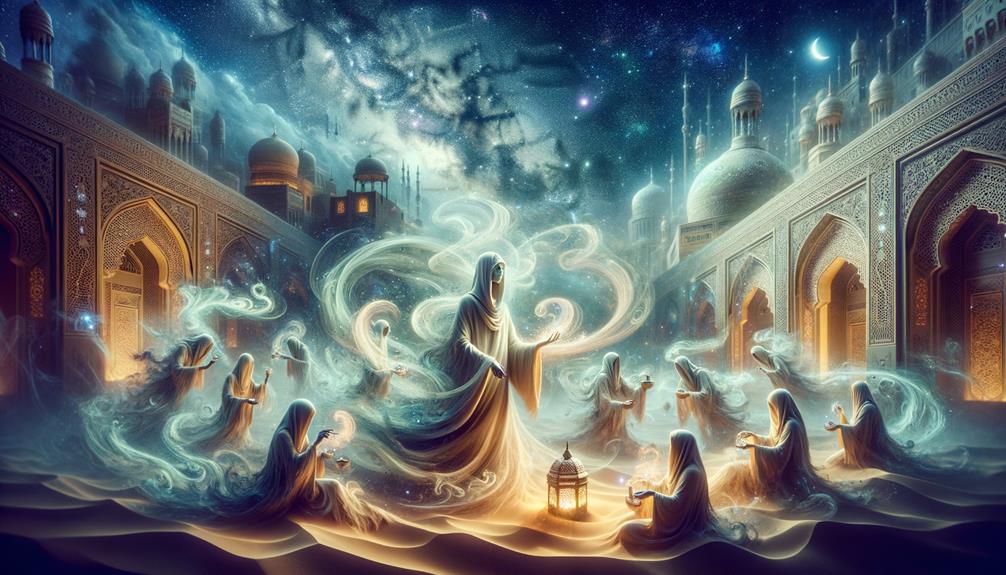
Enter the Realm of Jinn in Magical Practices
We embark on a captivating journey into the mystical world of jinn in magical practices. These Arabian spirits, both benevolent and malevolent, are often summoned to lend their power for protection or assistance. Some even believe they're ruled by a king, adding another layer of intrigue to their existence.
1. Jinn as Protectors and Aides
In the realm of magic, jinn are often summoned for their protective qualities or assistance. Their role varies from being seen as demonic entities to guardian spirits, depending on who you ask. As a protective measure against malevolent jinn, people often wear amulets inscribed with the name of God.
2. Jinn in Sorcery and Ailments
The jinn's reputation takes a dark turn in the world of sorcery. It's believed that these unseen spirits can be dispatched by sorcerers to cause harm. Their invisible presence is often blamed for various afflictions, making them a fearful component of Arabian mythology.
3. Human-Jinn Interactions
The relationship between humans and jinn is intricate and fascinating. It's suggested that jinn can engage in intimate relationships with humans, even producing offspring. If harmed, these spirits can retaliate or possess individuals, instilling both fear and awe in their magical role.
Jinn in Comparative Mythology
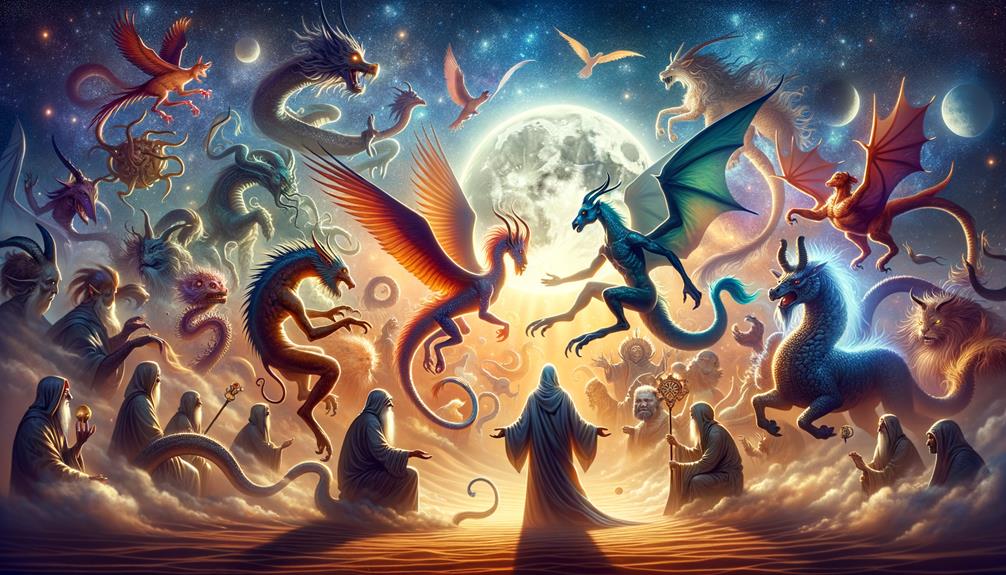
Understanding Jinn: A Comparative Mythological Perspective
Jinn, the captivating entities from various cultural histories and folklore, have taken a prominent place in the global imagination. These enigmatic beings transition effortlessly between the unseen and the seen, connecting the celestial and terrestrial realms. They are not visible to the human eye unless they decide to morph into something perceivable, injecting an element of mystery and allure into countless narratives across diverse cultures.
Jinn in Pre-Islamic Arabia: From Worship to Lower Ranking
In pre-Islamic Arabia, jinn occupied a unique position, revered as divine entities by the earth's inhabitants. This stands in stark contrast to their depiction in Islamic tradition, where worship is exclusively dedicated to Allah. Here, jinn are positioned lower than angels but maintain the capability to engage with our realm, hinting at their multifaceted nature.
Jinn's Cultural Influence: A Blend of Fear and Fascination
Transitioning through different belief systems, jinn continue to wield influence in modern societies, particularly within Islamic cultures. They're perceived as inhabitants of a parallel, unseen dimension, possessing the power to impact human behavior. The human-jinn relationship is a complex tapestry, often portrayed in literature and poetry as a blend of trepidation and enchantment.
By examining jinn through a comparative lens, we can fully appreciate their enduring significance in shaping cultural narratives and collective imaginations. This approach helps us understand their role, influence, and the fascination they inspire across different cultures.
The Modern Impact of Jinn: A Fascinating Study
In contemporary culture, jinn continue to play a significant role. They are often portrayed in movies and literary works, reflecting the ongoing interest and intrigue these unseen entities inspire. For a deeper understanding of jinn's cultural impact, we recommend reading "The Jinn in Islamic Art and Literature" by Amira El-Zein.
This exploration of jinn not only enriches our understanding of global mythology but also reveals the profound impact of these unseen entities on our collective imagination. With their unique blend of mystery and allure, jinn continue to shape cultural narratives and inspire fascination across the globe.
Frequently Asked Questions
What Is the Mythical Creature Jinn?
Understanding the Mystical Jinn
Diving into the realm of Islamic beliefs, we encounter the fascinating creature known as the jinn. This elusive entity, unseen to the human eye, possesses the intriguing power of shape-shifting.
The Jinn's Origin and Nature
Crafted from a unique substance – a smokeless fire – the jinn's nature is a testament to its extraordinary origin. Their remarkable ability to exercise moral freedom resembles our own human capacity to choose our path. These mystical beings have the liberty to accept or defy the divine guidance of God, just as we do.
The Jinn and Moral Freedom
Just imagine being able to shape-shift and being made of smokeless fire! Yet, despite these extraordinary abilities, the jinn shares a common trait with us – moral freedom. They can heed or ignore God's counsel, a choice that mirrors the moral decisions humans grapple with every day.
Invisible, Shape-shifting, and Free-willed: The Jinn's Unique Traits
The jinn's unique traits set them apart in the rich tapestry of Islamic mythology. Their invisible existence, their capability to alter forms, and their moral autonomy make them a riveting subject of study.
In short, the jinn personify the profound concept of moral freedom within an invisible, shape-shifting form made from smokeless fire. Their intricate blend of fascinating characteristics makes them a compelling feature of Islamic beliefs.
Remember, just like the jinn, we possess the power of choice. We can choose to follow the path of good or stray into the shadows of moral ambiguity. So let's embrace our shared moral freedom, appreciate the complexities of our decisions, and strive to navigate our choices wisely.
The exploration of mythical creatures like the jinn not only expands our understanding of cultural beliefs but also provides intriguing parallels to our own human experience.
What Are the Different Types of Jinn in Arabic?
Discover the Intriguing World of Arabic Jinn Types
In the fascinating realm of Arabic folklore, we encounter an array of jinn types, each endowed with unique traits and abilities. Let's delve into these captivating characters and their interaction with humans.
The Elusive Ifrit
The Ifrit ranks among the most notorious jinn, known for their mischievous nature. They are not merely whimsical spirits, but entities that engage in a lively interplay with humans. In tales, they often disrupt the tranquil life of unsuspecting individuals, adding an element of surprise and intrigue.
The Mighty Marid
Stepping into the scene of powerful genies, we find the Marid. These jinn are renowned for their immense power and might. They are the epitome of the classic genie, capable of granting wishes and performing feats beyond human comprehension.
The Shape-Shifting Ghul
One of the most enigmatic jinn is the Ghul, a shape-shifting demon that leaves a mark on Arab tales. Their ability to morph into different forms and their interactions with humans add a layer of mystique to their narrative.
Remember, these are just a few examples of the many types of jinn that populate Arabic folklore. Each has its unique flavor, offering a rich tapestry of tales and lessons.
Engage with the World of Jinn
Exploring the world of jinn is not just a journey into the paranormal, but also an engaging way to understand Arabic culture and literature. So, why not dive in? Pick up a book or watch a movie that features these compelling entities. You'll be amazed at the depth and diversity of these captivating tales.
This is an invitation to explore, engage, and delve deeper into the enchanting world of Arabic folklore. Let the tales of jinn whisk you away into a realm of intrigue and fascination.
"Arabic folklore is a treasure trove of captivating tales. Each jinn type is a unique narrative, a vibrant thread in the rich tapestry of Arabic storytelling."
What Is the Lore of the Djinn?
Understanding the Enchanting Lore of Djinn
In the fascinating world of mythology, the Djinn stand out as remarkably potent spirits, admired for their ability to shape-shift and sway the course of human events. Their association with elements of protection, enchantment and, rather unsettlingly, possession, lends an air of suspense and intrigue to their narrative.
The Power of Djinn: Shape-Shifting and Human Influence
The Djinn, unique in their abilities, are said to be capable of shape-shifting. This exceptional power allows them to alter their form at will, a trait that contributes significantly to their mystique. Furthermore, their capacity to impact human affairs is a testament to their inherent potency.
Protection, Magic, and Possession: The Diverse Attributes of Djinn
Their lore doesn't stop at shape-shifting and influence. Djinn are also tied to facets of protection and magic. Their protective nature often paints them as guardians, while their magical abilities offer an exciting dimension to their character. However, the aspect of possession brings a chilling twist to their tale, infusing their mythology with a healthy dose of fear and fascination.
Embracing these fascinating elements of Djinn lore offers a unique window into a world of powerful spirits and captivating mythology. The narrative of the Djinn is a compelling journey into the realm of the supernatural, brimming with intrigue and suspense. It's a tale that's as engaging as it is thought-provoking, and it's sure to leave you hungry for more.
What Are the Mythical Creatures in Islam?
Exploring the Mystical Realm of Islam: A Dive into Its Mythical Creatures
Islam, a faith rich in tradition and teachings, provides a fascinating array of mythical creatures. This vast spectrum includes angels, devils, and otherworldly beings such as the Houri. It's crucial to understand that these entities are not merely figments of imagination, but are deeply intertwined with the faith and religious doctrine of Islam.
Let's delve deeper into these spiritual entities in Islam. Each one has its unique characteristics and roles, contributing to the spiritual richness of the religion. The Angels, for instance, serve as messengers of God, carrying out His divine will. On the other hand, devils, or 'Shayatin' in Arabic, are the embodiment of evil, seeking to lead humans astray. The Houri, described as celestial beings of exceptional beauty, are believed to dwell in paradise.
These entities, while mythical, play a significant role in the spiritual journey of Muslims, guiding their behavior and shaping their beliefs. It's interesting to note that these beings are more than just cultural symbols; they represent the complexities of good and evil, reward and punishment, in the Islamic worldview.
While exploring the mystical creatures in Islam, it's essential to approach the topic with respect, recognizing its significance in the faith. Remember, understanding these spiritual entities can provide a deeper insight into the Islamic religion, making it more engaging and comprehensible.
In conclusion, the mythical creatures in Islam, ranging from angels to devils, and supernatural beings like the Houri, are deeply embedded in faith and religious teachings. They are not just figures of folklore, but integral parts of the Islamic religion.

